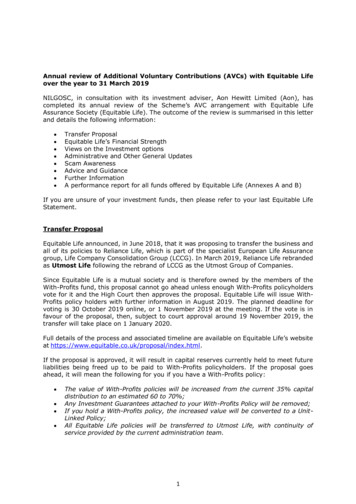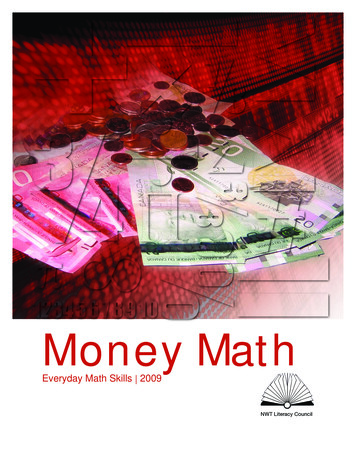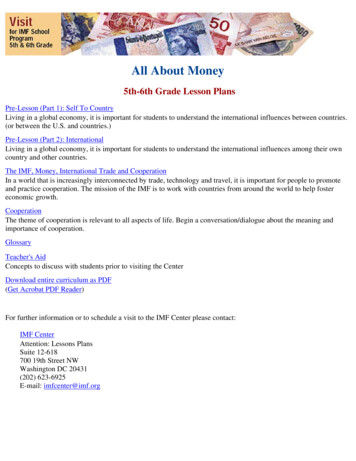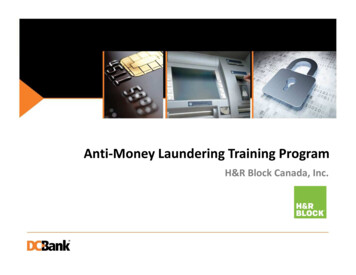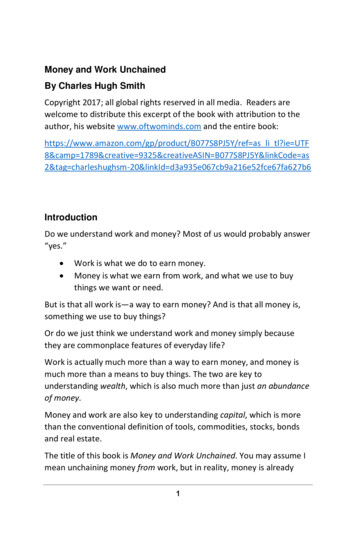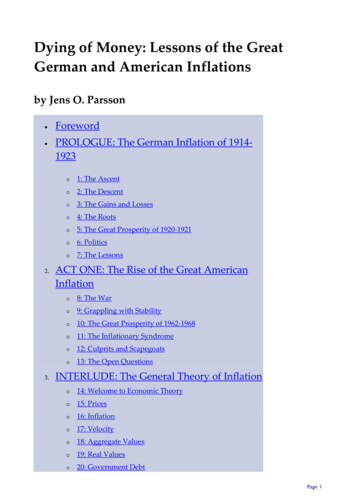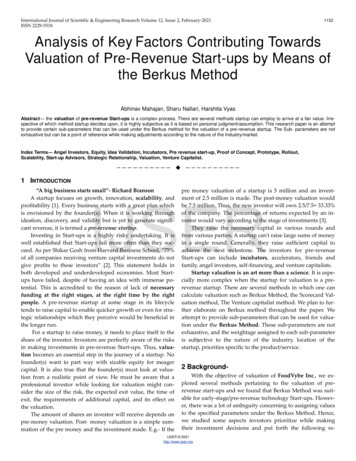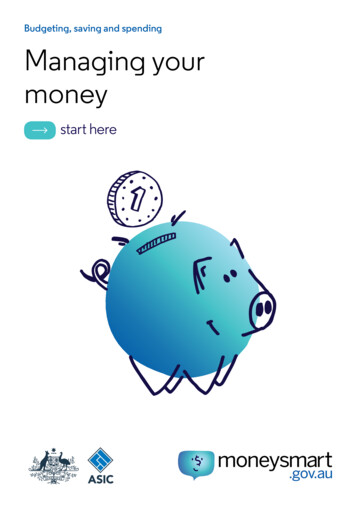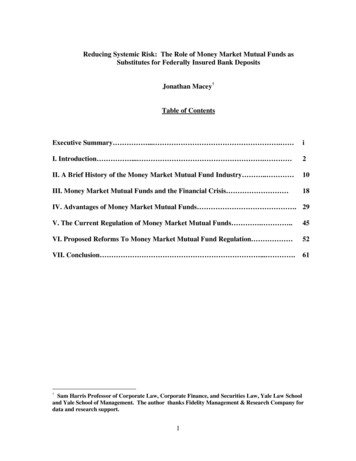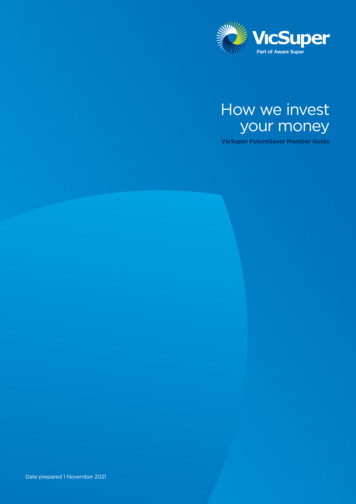
Transcription
How we investyour moneyVicSuper FutureSaver Member GuideDate prepared 1 November 2021
VicSuper FutureSaver Member GuideContentsYour investment options 3Responsible Ownership 5Our investment approach 7Important information about the investment options 9Understanding the asset classes 10Diversified options 12Single asset class options 15About the Socially Conscious option 17Risks of super 20Changing your investment options 22Unit prices 24Other useful information 25The information in this document forms part of the VicSuper FutureSaver Product Disclosure Statement(PDS) dated 1 November 2021.Issued by Aware Super Pty Ltd (ABN 11 118 202 672, AFSL 293340) the trustee for Aware Super (ABN 53 226 460 365). This Member Guide has been preparedby Aware Super Pty Ltd (referred to in this document as the ‘Trustee’, ‘we’, ‘us’, ‘our’), the trustee for Aware Super (referred to as ‘Aware Super’ or ‘the Fund’).VicSuper is a division of the Fund which includes the VicSuper FutureSaver product. The Fund is governed by a trust deed (‘Trust Deed’) as amended fromtime to time. For a copy of the Trust Deed see vicsuper.com.au/trustdeed or alternatively, you can contact the Member Centre on 1300 366 216.VicSuper FutureSaver was previously a product in the Victorian Superannuation Fund. It is now offered by the Trustee as a result of the transfer of all membersand assets in the Victorian Superannuation Fund to the Fund on 1 July 2020. The Victorian Superannuation Fund no longer exists as a separate fund.This publication contains general information only and does not take into account your specific objectives, financial situation or needs. Seek professionalfinancial advice, consider your own circumstances and read the VicSuper FutureSaver product disclosure statement and target market determination beforemaking a decision about investing in the VicSuper FutureSaver product. Contact us to make an advice appointment. Advice is provided by Aware FinancialServices Australia Limited (ABN 86 003 742 756, AFSL 238430), our financial planning business which is wholly owned by us. You should read the AwareFinancial Services Australia Limited Financial Services Guide before making a decision. For more information call the Member Centre on 1300 366 216.The information contained in this document is given in good faith and has been derived from sources believed to be reliable and accurate. No warranty as tothe accuracy or completeness of this information is given and no responsibility is accepted by the Trustee or its employees for any loss or damage arisingfrom reliance on the information provided. If there is an inconsistency between the information in this document and the terms of the Trust Deed, the TrustDeed will prevail.2
VicSuper FutureSaver Member GuideYour investment optionsGrowing your savings for a comfortable retirement partly comes down to making good investmentchoices. We offer a range of diversified and single asset class investment options.Choose from nine investment optionsGenerally, you can choose to invest in one or more of theinvestment options in whatever proportions you choose.You can also make different choices for your currentaccount balance, future contributions and amountstransferred to VicSuper from another fund.Our diversified investment optionsThe diversified investment options provide you with thebenefit of diversification by being invested across differentasset classes, investment styles and managers.Our Socially Conscious investment optionThe Socially Conscious investment option is a diversifiedinvestment option designed for members wanting to avoidparticular industries and companies that don’t align withtheir values. A key feature of the option is that it excludesinvestments considered to have a highly adverseenvironmental or social impact.For more information, including the screening criteriaapplied to the option, refer to ‘About the SociallyConscious option’ on page 17 and the relevant investmentoption in the table on page 13.Diversified optionsOr you don’t have to chooseEquity GrowthIf you don’t make a choice when you join, we’ll invest yoursuper in the Growth (MySuper) option. This will apply toyour account balance, future contributions and rollovers.The Growth (MySuper) option is a diversified option, whichmeans it is invested across a range of asset classes. This iscalled diversification and it can reduce the risk of loss ifone particular asset class performs poorly.Growth (MySuper)Socially ConsciousBalancedCapital StableCapital SecureOur single asset class optionsThe single asset class options give you a greater degree ofcontrol over your account by allowing you to invest in asingle asset class.Single asset class optionsAustralian SharesCashTerm DepositWe may add, close, or terminate investment options, addor remove investment managers, or alter the objective,strategic asset allocation or asset allocation range of aninvestment option, including the Growth (MySuper)option, at any time. We will notify you about any materialchanges, although this may be after the change hasoccurred. If you have money in an investment option thatthe Trustee decides to discontinue, you may have anopportunity to switch to any of our other investmentoptions. Alternatively, we may switch your money to aninvestment option with a similar risk/return profile.If you choose your own investment option(s), you shouldreview your choices from time to time as you will remainin your chosen investment option(s) until you chooseotherwise. You should also keep in mind that the single assetclass investment options are not as well diversified comparedto our diversified options and do not provide access toasset classes other than cash and Australian equities.We are not responsible for your investmentchoice and we do not review your investmentchoice. If you select one or more of the singleasset class options without adequatelydiversifying your investment in the Fund, youcould be exposing your superannuation benefitsto a greater risk of loss. Please read ‘Theimportance of diversification to manageinvestment risk’ on page 21. You may wish toconsult a financial planner before making anyinvestment decisions.Important informationThe value of assets in the Fund’s investmentoptions may rise and fall from time to time.Nothing in this Member Guide is intended toforecast the future performance of the Fund orany of its investment options. Past performanceis not a reliable indicator nor is it a guarantee offuture performance. We do not guarantee thecapital invested or the investment performanceof any of the investment options available tomembers in the Fund.3
VicSuper FutureSaver Member GuideInvestment options expected risk and return profileExpected ReturnGrowth(MySuper)BalancedEquity GrowthSocially ConsciousCapital StableCapital SecureExpected RiskLower RiskHigher RiskNote: The above graph provides a broad overview of the expected risk and return for the diversified investment optionsfor comparison.It is illustrative only and is not a forecast or guarantee of the future returns of the investment options shown. Similarly, itshould not be relied on as providing an accurate indication of the level of risk associated with any one option. Eachoption is subject to different types of risks and can be impacted by those particular risks to varying degrees dependingon the nature of the option’s investments.For more information on each investment option refer to pages 12 to 16 of this guide.4
VicSuper FutureSaver Member GuideResponsible OwnershipWe integrate environmental, social and governance (ESG) considerations into our investmentprocesses across all of our investment options and asset classes. Known as Responsible Ownership,this approach helps us better manage risk and generate strong long-term returns for our members,while also contributing positively to the world in which our members live and retire.We believe it is important to take ESG considerations intoaccount since a company’s approach to managing ESGrisks and opportunities can have a meaningful impact onits long-term viability and success. Over the long term, wethink companies and assets with sound ESG managementare more likely to increase in value. By contrast, companiesthat poorly manage ESG risks have the potential todestroy shareholder value and may also harm the broadercommunity and environment.Our Responsible Ownership approach consists of fourmain pillars which are outlined below. We understand thatthings can change quickly, and this multi-faceted approachmeans we are able to identify emerging ESG risks andissues and respond appropriately.Pillar 1: IntegrationOur approach is not limited to a set-and-forget analysis ofan investment, but rather is a holistic approach toassessing ESG risks and opportunities over an investment’slife. We do this by considering ESG factors both at thetime of initial investment due diligence and selection(ie before we make a new investment), and via ongoingmonitoring thereafter.When we are considering partnering with an externalinvestment manager, we assess their ESG capabilities andpolicies before deciding to invest with them. We alsoregularly meet with them to review their ESG integrationapproach and discuss how they are monitoring ESG risksand issues. While we expect the investment managers wepartner with to monitor ESG risks that relate to ourinvestments, we allow them some flexibility to determinethe manner in which ESG considerations are implemented.Examples of some of the key ESG factors we consider areprovided below.Environmentalfactors Climate change and its potentialimpact on investments Waste, pollution and contamination Water (eg availability and supply) Biodiversity and sustainable land useSocial factors Workplace health and safety Diversity and inclusion Adherence to internationalconventions Modern slavery/forced labour(both in company operations andsupply chains) The effectiveness of a company inmaintaining its ‘licence to operate’and managing labour relations Product responsibilityGovernancefactors Board composition (diversity,expertise & independence) Executive remuneration Transparency & reporting Conduct & culture Technology & innovation Data privacy & cyber securityWe may take into account other ESG factors if they applyto a particular investment or investment manager.Where investment managers take into account ESGconsiderations, they may consider different ESG factors.Pillar 2: VotingAs a large investor we own shares in a diverse range ofcompanies which entitles us to vote on various matters.We use our voting rights to support resolutions that seekto enhance value for our members across a range of areassuch as board composition, executive remuneration, andclimate-related disclosure and action. Information on ourvoting decisions is available on the website atvicsuper.com.au/responsibleinvestment.Where applicable, external and internal investmentmanagers are expected to actively consider their positionon company resolutions. However, the Trustee has theright to any final voting decision and can override amanager’s vote.5
VicSuper FutureSaver Member GuidePillar 3: EngagementWe monitor ESG considerations continually, and when amaterial risk or issue is identified we use our ownershiprights to engage with the relevant company, particularlywhere we believe its management of ESG issues isdeficient relative to government/regulator or industrystandards and/or community expectations, or its conductthreatens its reputation and value. The objective ofengagement is to encourage the company to improve itsESG policies and practices, and thereby protect or increaseits economic value. Where engagement does not lead tothe desired outcome or changes within a reasonabletimeframe, other actions such as voting against directors,or raising a Shareholder proposal, are considered. Incertain circumstances, divestment from a particular sectoror company may be considered. Refer to the section ‘Ourinvestment restrictions and exclusions’ for more information.Pillar 4: Collaboration & advocacyWe believe we can be more effective and have a morematerial impact by working alongside other like-mindedinvestors and industry associations. We are a signatory tothe Principles for Responsible Investment (PRI) and areinvolved in a number of collaborative initiatives. Thisincludes the Australian Council of Superannuation Investors(ACSI), Responsible Investment Association of Australasia(RIAA), Climate Action 100 , the Investor Group on ClimateChange (IGCC), 40:40 Vision, Investors Against Slavery andTrafficking Asia Pacific (IAST APAC), the Carbon DisclosureProject and the Water Disclosure Project.Collaborating with other large investors in these initiativeshelps us to better understand the risks and opportunitiesassociated with various ESG issues across a range ofindustries and sectors.Climate changeWe believe climate change is one of the most significantlong-term risks to our portfolio – and therefore ourmembers’ retirement outcomes. As a result, we haveundertaken significant research and work to establish aplan to help us address the large, systemic and structuralchanges that limiting temperature rises and climatechange will require. Our plan, known as the ClimateChange Portfolio Transition Plan, is a framework ofrecommendations and targets that will focus our efforts on: developing a decarbonisation pathway for ourinvestment portfolio transitioning our portfolio to lower climate change riskin our investments and, where required, helping thoseinvestments adapt to a changing climate, eg workingwith our agricultural investments to help them adapttheir practices to a warming and changing climate proactively investing to capture opportunities in energyefficient investments that will emerge as we movetowards a decarbonised economy, and lowering risk through actively managing and engagingwith portfolio investments on their climate changetransition pathway.In relation to our equities portfolios we have introducedcustom benchmarks for portfolios that are managedpassively or using a quantitative style (meaning managedusing mathematical modelling, computer systems anddata analysis). In addition to excluding the fund-wideexclusions outlined below, these custom benchmarksexclude, or have a reduced weighting to, the most carbonintensive companies from the respective benchmarksbased on emissions and fossil fuel reserves data. This is inline with our target to reduce the carbon exposure in ourequities portfolio by at least 30% by 2023.You can find more information on our Climate ChangePortfolio Transition Plan on our website atvicsuper.com.au/transitionplanOur investment restrictions and exclusionsWhile in general our approach is to use engagement andproxy voting to positively influence the behaviour and ESGpractices of the companies we invest in, in certaincircumstances we believe it is appropriate to exclude aparticular sector or company from our investmentportfolios. These circumstances include: if we consider that an investment is inappropriate to theextent that it may have a negative reputational impact if the investment would lead to contravention ofinternational treaties or conventions that Australia is asignatory to; or if it is not deemed possible to influence a companythrough engagement or proxy voting.On this basis, we have implemented the below portfoliowide restrictions and exclusions.1. Tobacco – direct investments in tobacco manufacturersand/or producers (including subsidiaries, joint venturesand affiliates) which derive 5% or more of their revenuefrom the manufacture and/or production of tobaccoproducts.2. Thermal coal – direct investments in companies thatgenerate 10% or more of their revenues directly frommining thermal or energy coal.13. Controversial weapons – direct investments incompanies that derive any revenue from themanufacture and/or production of controversialweapons including chemical weapons, clustermunitions, land mines and depleted uranium.Note that the above exclusions don’t apply to the use ofderivatives which may have an indirect exposure to thesetypes of companies. In addition, implementation of theabove exclusions may be affected by the accessibility andaccuracy of data, or an error by an external service provider.This may result in inadvertent holdings, typically over theshort term, in investments we are seeking to exclude.We may divest from other sectors, industries or investmentswithout prior notice, in line with our Responsible InvestmentPolicy as updated from time to time.For more information, you can read our ResponsibleInvestment Policy, available at vicsuper.com.au/responsibleinvestment or you can obtain a copy, freeof charge, by calling us on 1300 366 216.1. Due to liquidity constraints, unlisted thermal coal mining assets may taketime to divest from and there may be a small residual exposure. Suchassets will be sold at fair value as soon as reasonably practicable, but byno later than 30 June 2023.6
VicSuper FutureSaver Member GuideOur investment approachInvestment overview – diversified optionsAsset AllocationOur investment approach is designed to meet the differingneeds of our members, in accordance with our responsibleownership principles. Our focus is on investing in adiversified mix of good quality assets that can grow yoursavings over time. We take care when choosinginvestments and seek to only take on risk that we believewill be adequately rewarded.Our asset allocation approach is designed to smooth theimpact of market ups and downs and aims to optimise riskand return outcomes over all timeframes. We manage ourinvestments to take account of short-term risks, but alsoby having an over-arching and longer-term risk-adjustedstrategy that aims to maximise your long-term savings.Our asset classes often comprise a blend of investmentapproaches and include liquid and illiquid investments.A Members First approachMember outcomes are at the core of our investmentapproach and inform the investment objectives andstrategy assigned to each investment option. Weunderstand that members’ needs from superannuationchange over time.We tailor the way we manage our options to meet theseneeds, focusing on growth in options typically used bymembers building their super balance.In our products designed to be used by members inretirement, we incorporate a greater focus on riskmanagement for the more conservative options, with theaim of reducing the impact of large market falls.Investing in a range of assetsWe have determined an appropriate split between growthand defensive assets for each option that is consistent withthe option’s risk level and is most likely to meet theoption’s investment objective. Growth assets have the potential to achieve capitalgrowth over the medium to long term. Examples includeAustralian equities, international equities and privateequity. While in the long term these types of assets havethe potential to produce higher returns, they can bemore volatile (or risky) in the short term when comparedwith defensive assets and have a greater potential toproduce negative returns in the short to medium term. Defensive assets (previously referred to as ‘incomeassets’) generally provide an income stream andtypically include cash, fixed income investments (bonds)and alternative debt/credit income. These investmentsare generally less risky than growth assets, but can attimes produce a negative return.Each option has a medium to longer term target assetallocation, known as the strategic asset allocation, as wellas asset allocation ranges which are the minimum andmaximum amounts we can invest in each asset class. Thestrategic asset allocation and asset allocation ranges foreach investment option, as at the date of this MemberGuide, are shown in the investment option tables on pages12 to 16. Note that each of the asset classes may includesmall cash balances for portfolio management purposes.Our strategic asset allocation sets our risk appetite andmix of asset classes over the long term. The actual assetallocation in place at a particular time may vary from thestrategic asset allocation due to short to medium-termfactors that require a change in our portfolio. We may varyour allocations from the strategic asset allocation tomanage asset class risk dynamically over an investmentcycle, and to take advantage of short-term opportunities.These deviations from the strategic asset allocation aregenerally in place for a short to medium-term period andmust be consistent with the investment objective andstrategy of the option. While generally the actual assetallocation will be within the strategic asset allocationranges, during an episode of significant market stress theactual asset allocation may move outside the rangesshown in the investment option tables.We may vary the strategic asset allocationand asset allocation ranges for an investmentoption from time to time without prior notice.The latest asset allocations can be found atvicsuper.com.au/assetallocationsWe consider some asset classes, such as property,infrastructure, and liquid alternatives to be part growth,part defensive.For more information on what is included in each assetclass, refer to ‘Understanding the asset classes’ on page 10.7
VicSuper FutureSaver Member GuideProfessional investment managers investyour moneyWe work with a panel of professional investmentmanagers who specialise in different asset types toassist us in managing your super. A current list ofmanagers by asset class is available on our website atvicsuper.com.au/investmentmanagersWe also have a team of investment specialists whooversee our investment portfolios and manage a number ofinvestments in house. The investment team seeks to delivervalue to members with an approach that focuses on: Asset allocation to get an appropriate mix of differentinvestment types over all time frames. High quality research to underpin and improveinvestment decisions. Managing select investments in house, whichbrings market insights and greater access tounique opportunities. Integrating ESG considerations into theinvestment process. Active ownership and engagement to drivepositive change with the companies we invest in.The team also performs a cash flow and portfoliorebalancing function for the diversified investmentoptions to help ensure each option is invested as closelyas possible in line with the target asset allocations.Investment approachesInvestment managers use different approaches to selectinvestments, with two of the main approaches, passiveand active management, described below. No singleapproach is guaranteed to outperform all others in allmarket conditions.Passive managementAlso known as index managers, passive managers chooseinvestments to form a portfolio that closely tracks amarket benchmark (or index). Passive managers usuallycharge lower fees because they don’t require extensiveresources to select investments.Active managementActive managers select investments which they believewill perform better than a market benchmark over thelong term. They buy or sell investments when theirmarket outlook alters or their investment insights change.8
VicSuper FutureSaver Member GuideImportant information about theinvestment optionsInvestment objectivesEach investment option has a stated objective which is thedesired investment outcome for the option. Investmentobjectives vary with the level of risk associated with theassets that make up the option. Keep in mind whenreviewing the options’ objectives that they are not aforecast of future returns, or prediction of the earnings onyour investment.For each diversified option, the investment objective is toachieve investment growth above inflation (as measured bythe Consumer Price Index) over rolling time periods. Bycontrast, the investment objectives for the single asset classoptions are generally to track or outperform a relevantmarket benchmark or index, for example in the case of theCash option, the Bloomberg AusBond Bank Bill Index.On 1 October 2020 we introduced custom benchmarksfor our single asset class equities options. In addition toexcluding our fund-wide exclusions in relation to tobacco,thermal coal and controversial weapons, these custombenchmarks exclude, or have a reduced weighting to, themost carbon intensive companies from the respectivebenchmarks based on emissions and fossil fuel reservesdata. This is consistent with our target to reduce thecarbon exposure in our equities portfolio by at least 30%by 2023. Note that the benchmarks are dynamic andrebalanced each quarter, and the constituents cantherefore change over time. For more information on ourfund-wide exclusions, refer to the ‘ResponsibleOwnership’ section.We may change the investment objective of an investmentoption from time to time.Standard Risk MeasuresThe investment option tables on the following pages showa risk band, risk label and estimated number of negativeannual returns over any 20-year period for eachinvestment option. This is known as the Standard RiskMeasure, or SRM, and is based on a methodologydeveloped by the industry so that consumers can compareinvestment options within and across funds. As shown inthe table below, the risk measures range from 1 (being thelowest risk) to 7 (being the highest risk). The SRM of aninvestment option depends on the risk profile of the assetclasses and investments that make up the option.RiskbandRisklabelEstimated number ofnegative annual returnsover any 20-year period1Very lowLess than 0.52Low0.5 to less than 13Low to medium1 to less than 24Medium2 to less than 35Medium to high3 to less than 46High4 to less than 67Very high6 or greaterForeign currency managementWhen investing in overseas assets such as internationalequities or bonds, returns reflect both changes in the valueof the underlying investments, as well as currencymovements. We may hedge some or all of the currencyexposure back to Australian dollars in order to manage riskor enhance returns.On each investment option profile we show the targetforeign currency exposure and range. These amounts referto the proportion of assets that are subject to foreignexchange rate movements. The remainder of theinvestment option is either currency hedged ordenominated in Australian dollars.We may change the currency exposure over time with theintention of improving the investment option’s ability tomeet its performance and risk objectives.Different options may carry different levels ofrisk, depending on the assets that make up theoption. When choosing an investment option,you should consider the level of investment riskthat is appropriate for you, which depends onyour age, investment timeframe, where otherparts of your wealth are invested and yourattitude to risk. Seeking advice from a financialplanner can help you choose the most suitableinvestment option.It’s important to keep in mind that the SRM is not acomplete assessment of all forms of investment risk. Forinstance, it does not take into account the potential size ofa negative return, or the potential for a positive return tobe less than a member may require to meet theirobjectives. In addition, it does not take into accountadministration costs.9
VicSuper FutureSaver Member GuideUnderstanding the asset classesAn asset class refers to a group of assets that areconsidered to have similar risk and return characteristics.The information below describes the asset classes yoursuper may be invested in.CashCash investments include a range of short and mediumterm interest-bearing investments, such as term deposits,bank bills and treasury notes. For the diversifiedinvestment options, the Cash asset class can also includecorporate debt and asset-backed securities which aim toadd value while substantially retaining the low-riskcharacteristics of more traditional cash investments.Typically the least risky of all asset classes, cash is oftenchosen by investors who want to access their money in theshort to medium term. However, while the risk of negativereturns from cash investments is much lower than for otherasset classes, expected returns are also lower, particularlyin a low interest rate environment. The buying power ofyour money may also be reduced as it may not keep upwith inflation.The value of a cash investment will fluctuate due to anumber of factors, but primarily with the rise and fall ininterest rates.Equities (shares)Equities (shares) are a portion or share of a company thatcan be bought or sold on an exchange. Equities allowinvestors to access both large and small listed companiesacross a range of industries in Australia and overseas (bothdeveloped and emerging markets).The return investors receive from investing in equitiesincludes income in the form of dividend payments, as wellas capital gains (and losses) from changes in the value ofthe underlying shares, and for international equities,currency movements.Long-term returns from equity investments tend to behigher than those achieved from property, fixed incomeand cash investments. But in the short term, theirperformance is more volatile and returns can be negative,making them a higher risk investment.Various factors like consumer sentiment, commodityprices and company performance can all have an impacton a company’s share price.Note that our Australian and international equities assetclasses can also include a small exposure to unlistedcompanies which are less liquid than listed companies.Fixed income (bonds)A fixed income investment is a loan to a government,semi-government authority or large corporation inexchange for regular interest payments, plus repaymentof the principal amount at maturity.Interest is paid to investors over the life of the investment,usually at a fixed rate. However, for some bonds, theinterest payments and/or principal are adjusted for the rateof inflation. These are known as ‘inflation-linked bonds’ andthey are designed to help protect investors from inflation.Whi
The Fund is governed by a trust deed ('Trust Deed') as amended from time to time. For a copy of the Trust Deed see vicsuper.com.au/trustdeed or alternatively, you can contact the Member Centre on 1300 366 216. . The value of assets in the Fund's investment options may rise and fall from time to time. . Capital Stable Capital Secure .
